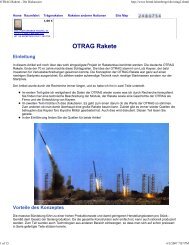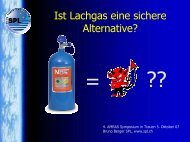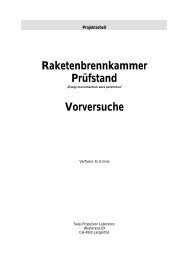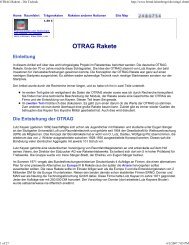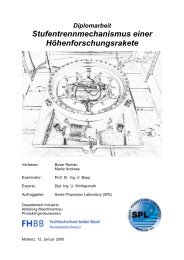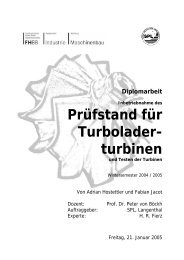You also want an ePaper? Increase the reach of your titles
YUMPU automatically turns print PDFs into web optimized ePapers that Google loves.
Level 3: 8 x CPMR (2x4 square)<br />
Level 2: 24 x CPMR (+8 = 32 CPMR CPMR = 4x8 rectangle)<br />
Level 1: 96 x CPMR (+24 CPMR CPMR = 128 = 8x16 rectangle)<br />
This missile would be 4.8x2.4 m wide at a height of 24 m. It has also been considered to<br />
extend the outer ring by 3 m in order to form the payload space. These engines would<br />
then burn 15 seconds longer. In later approaches you have rejected this idea again.<br />
The rapidly increasing width of the rocket and the bundling of many engines should<br />
provide an additional ideas to Lutz Kayser back fabric. As described, the nozzle end<br />
shortly after the combustion chamber, so that the gases at the nozzle exit, very little<br />
energy has been transferred to the rocket. Up of many engines connecting gas flows and<br />
accumulate it comes to a further rebound in order to increase the specific impulse for<br />
Kayser detail by 10-12%.<br />
The following standard versions were being considered (payload for a 200 km high orbit<br />
LEO)<br />
Total number of CPMR payload launch mass Level 1 Level 2 Level 3<br />
64 1 t 100 t 48 12 4<br />
T 200 t 128 2 96 24 8<br />
256 4 t 400 t 192 48 16<br />
512 8 t 800 t 384 96 32<br />
1024 16 t 1600 t 768 192 64<br />
The payload data refer to a low Earth orbit. The payload for the GTO orbit betrugNo text<br />
about 40% of it and the payload for the GSO orbit about 20% of them (this would be<br />
roughly the payload to Venus or Mars). A 200-ton rocket with 128 modules, so the<br />
payload would have had a Delta 3914, the standard model of the time, and a version with<br />
256 modules would be something worse than an Atlas-Centaur or Ariane 1 was.<br />
Mr. Kayser I first gave values of 24 m module, and when I complained inconsistencies,<br />
new data, which differed in the thrust and burn time of the first substantially. I have<br />
therefore both separately identified by a "/". Here, the data of a 24 m long module<br />
consists of a tank and an engine. This length would have been provided for an orbital<br />
version.<br />
Length 25 m<br />
Diameter 0:27 m<br />
Tank mass of 100 kg<br />
Engine 65 kg<br />
at the end of firing 50 kg<br />
Push the start 35 kN / 25 kN<br />
Thrust at the end of firing 15 kN / 15 kN<br />
Burn time 150 sec / 120 sec<br />
Oxidizer HDA 1130 kg<br />
Filling 66%<br />
Oxidizer length 18 m



